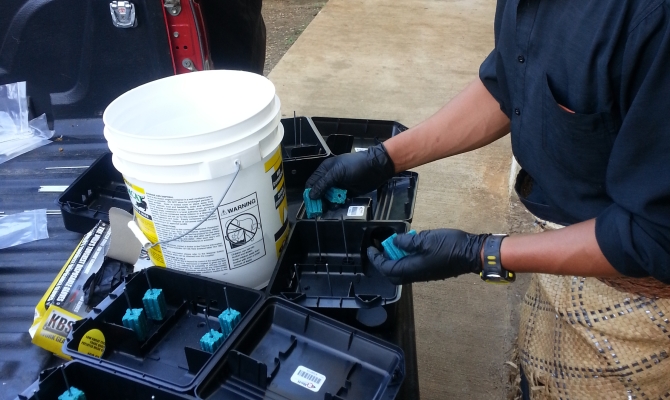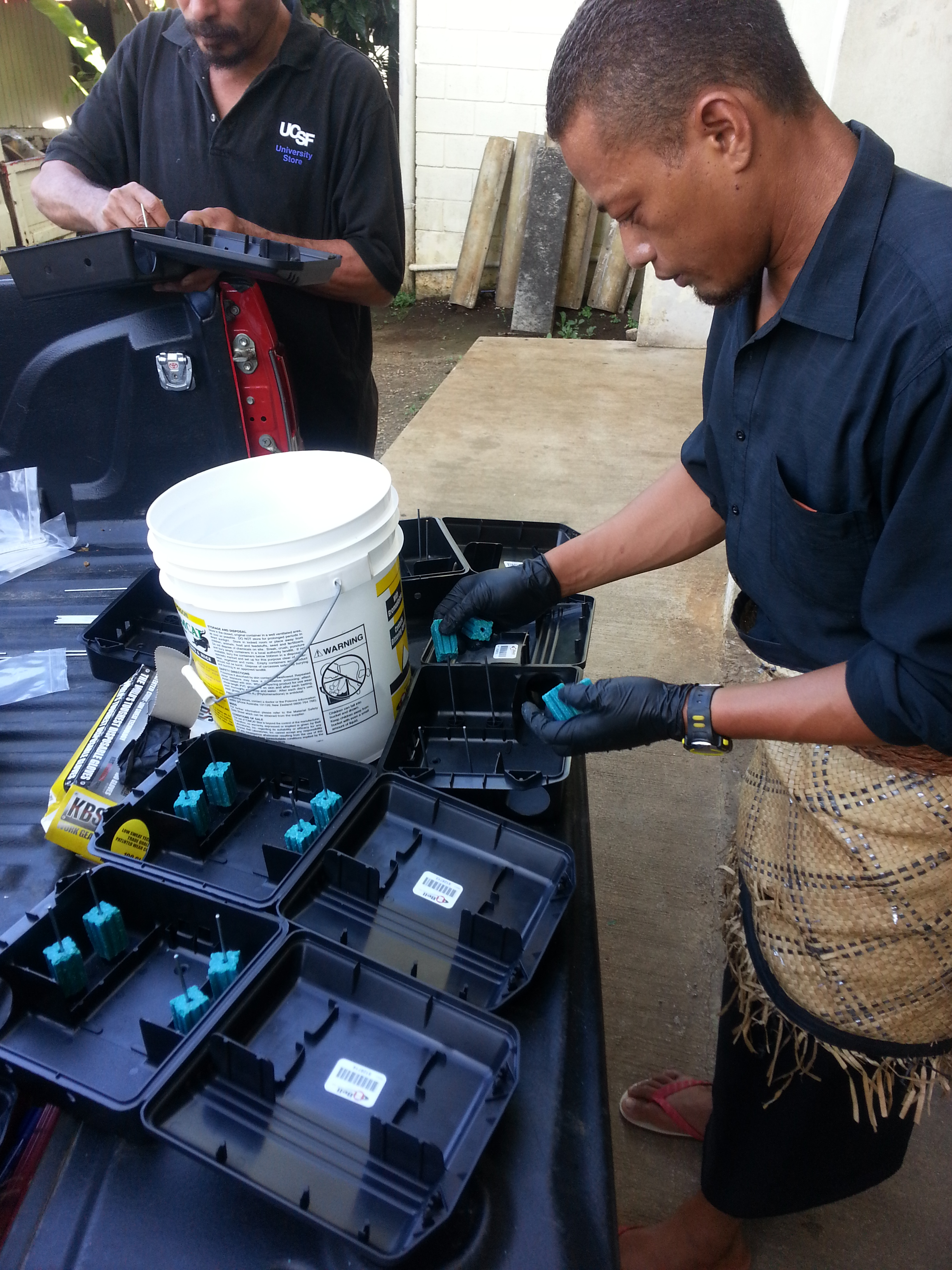
Biodiversity Conservation
Invasive species are one of the biggest threats to Pacific species and environments, and joining forces to prevent or manage invasive species helps to create real local actions.
The Pacific Invasives Learning Network (PILN), a peer learning network, helps to join the forces of 22 teams in Melanesia, Micronesia, and Polynesia through connecting in-country practitioners to share effective ways to battle invasive species.
Scheduled for 1–5 August in Samoa, the PILN2016 will bring the network together to define priorities and create working relationships.
PILN's mission is to empower effective invasive species management through a participant-driven network that meets priority needs, rapidly shares skills and resources, provides links to technical expertise, increases information exchange, and accelerates on the ground action.
 Senituli Finau prepares bait stations to remove invasive rats. Photo: David Moverley, SPREP
Senituli Finau prepares bait stations to remove invasive rats. Photo: David Moverley, SPREP
PILN is represented by multi-agency, multi-sector teams from 18 countries and territories.
"Invasive species cause more extinctions of endemic Pacific species than any other single cause. Invasive rats eat plant seeds and bird eggs, invasive weeds outcompete valuable crops and native plants, invasive birds like myna steal fruit and outcompete native birds," said Mr. David Moverley, Invasive Species Adviser of the Secretariat of the Pacific Regional Environment Programme (SPREP).
"Solving these problems relies on direct actions and institutional support."
Core activities of PILN include capacity building according to the priorities of teams, learning exchanges and attachments, and sharing of invasive species information through quarterly "Soundbites" and lessons-learned documentation.
PILN aspires to have teams of active invasive species practitioners in all of the member countries of SPREP and the Pacific Community (SPC).
The first PILN meeting was held ten years ago in in Palau, followed by meetings in 2007 (in Moorea, French Polynesia) and 2012 (on Kiritimati Atoll, Kiribati). The cost to host these meetings has been one of the major challenges contributing to the decision to hold in-person network meetings as needed. Each meeting has produced learning exchanges and functional relationships supporting field actions.
"Invasive species practitioners are the ones on the ground, taking on the fight against invasive species. They need the support of the region, their peers, and their communities to make this happen. The PILN Meeting is a significant step in this process," said Mr Moverley.
"The practitioners and experts at this meeting have the best regional knowledge, and sharing it helps protect the Pacific."
 PILN members studying restored environments. Photo: PILN
PILN members studying restored environments. Photo: PILN
Communication is a key component of the network, and collations of invasive species information from PILN teams and other relevant invasive species information from around the region and the globe are made available in the quarterly PILN Soundbites and the Battler Resource Base.
Opportunities for further training, scholarships, vacancies, and funding are also shared in the Soundbites, as are important upcoming events and relevant publications. The Soundbites are downloadable from the PILN website (www.sprep.org/piln).
For further information, please contact: Mr David Moverley, [email protected]
The Pacific Invasives Learning Network (PILN), a peer learning network, helps to join the forces of 22 teams in Melanesia, Micronesia, and Polynesia through connecting in-country practitioners to share effective ways to battle invasive species.
Scheduled for 1–5 August in Samoa, the PILN2016 will bring the network together to define priorities and create working relationships.
PILN's mission is to empower effective invasive species management through a participant-driven network that meets priority needs, rapidly shares skills and resources, provides links to technical expertise, increases information exchange, and accelerates on the ground action.
 Senituli Finau prepares bait stations to remove invasive rats. Photo: David Moverley, SPREP
Senituli Finau prepares bait stations to remove invasive rats. Photo: David Moverley, SPREP"Invasive species cause more extinctions of endemic Pacific species than any other single cause. Invasive rats eat plant seeds and bird eggs, invasive weeds outcompete valuable crops and native plants, invasive birds like myna steal fruit and outcompete native birds," said Mr. David Moverley, Invasive Species Adviser of the Secretariat of the Pacific Regional Environment Programme (SPREP).
"Solving these problems relies on direct actions and institutional support."
Core activities of PILN include capacity building according to the priorities of teams, learning exchanges and attachments, and sharing of invasive species information through quarterly "Soundbites" and lessons-learned documentation.
PILN aspires to have teams of active invasive species practitioners in all of the member countries of SPREP and the Pacific Community (SPC).
The first PILN meeting was held ten years ago in in Palau, followed by meetings in 2007 (in Moorea, French Polynesia) and 2012 (on Kiritimati Atoll, Kiribati). The cost to host these meetings has been one of the major challenges contributing to the decision to hold in-person network meetings as needed. Each meeting has produced learning exchanges and functional relationships supporting field actions.
"Invasive species practitioners are the ones on the ground, taking on the fight against invasive species. They need the support of the region, their peers, and their communities to make this happen. The PILN Meeting is a significant step in this process," said Mr Moverley.
"The practitioners and experts at this meeting have the best regional knowledge, and sharing it helps protect the Pacific."
 PILN members studying restored environments. Photo: PILN
PILN members studying restored environments. Photo: PILNOpportunities for further training, scholarships, vacancies, and funding are also shared in the Soundbites, as are important upcoming events and relevant publications. The Soundbites are downloadable from the PILN website (www.sprep.org/piln).
For further information, please contact: Mr David Moverley, [email protected]